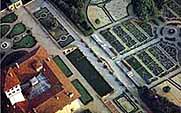
Front view
The original nucleus of this building was a large mediaeval defence tower
which belonged to the Brunelleschi family. Here, in 1364, the sons of Boccaccio
Brunelleschi successfully withstood the attacks of the Pisan troups, commanded
by the condottiere John Hawkwood, who was
later to become famous in the history of art thanks to his monument frescoed
by Paolo Uccello in the Duomo
of Florence.
The tower later fell into the possession of the Strozzi family or, at least,
until Cosimo dei Medici sent Palla Strozzi into
exile (1434). The building was confiscated in 1532 by Alessandro dei Medici,
the illegitimate son of Pope Clement VII and first Duke of Florence; later Cosimo I donated it to his son Ferdinando (1568).
At the time the building was part of a large farming estate which produced grain,
oil and fodder. Between 1575 and 1590, Bernardo Buontalenti worked at transforming
the fortress into a splendid villa, enlarging and restructuring it in order to
make it a pleasant and relaxing place for Cardinal Ferdinando, who succeeded
his brother Francesco I as Grand Duke in 1587.
Thus the turretted castle (only the central donjon remained as a tower-belvedere),
was transformed into an elegant square structure; Tribolo meanwhile planned the extensive grounds
that now also contain a fountain of his design, decorated by a statue in bronze
by Giambologna: Florence (or Venus) emerging
from the water (transferred here between 1739 and 1760 from the nearby villa
of Castello). The statue was moved to the interior of the villa
after the completion of recent restoration work.
The grounds are a splendid example of an Italian formal garden, the third to
be planned after the gardens of Castello and Boboli,
and are arranged on several levels to make the most of the irregular slopes that
surround the villa on three sides. Each level is linked to the others by flights
of steps and has its own particular function in the garden.
At the height of the villa, a lawn decorated with terracotta pots of citrus fruits
and statues leads on to a panoramic terrace overlooking the city and the Arno; this
is followed by the nursery gardens, surrounded by hedges cut into the shapes
of animals, and the main garden, divided into eight large flower beds which were
used for cultivating vegetables and for botanical experiments, one of the Medici family's
favourite sciences.

Garden
The upper part of the garden is planted with ornamental woodland;
paths link up the various areas of grassland and artificial lakes,
while the vegetation is used to create special perspective effects
that are meant to hide the real dimensions of the estate.
The 16th century parkland was very probably completed by architect Giulio Parigi,
who worked at the villa between 1631-32 to carry out various reinforcements and
decorations. Parigi apparently also carried out the drive that linked up the
villas of Petraia and Castello, which have always formed
part of this unique and enormous landed estate.
The courtyard with its internal loggia is the monumental fulcrum of the villa; two
walls are decorated by grotesque figures, dating from the late 16th century,
which were frescoed by Baldassare Franceschini, known as Volterrano,
with "Moments of Glory" of the Medici family and the Order of the Knights
of St. Stephen, established by Cosimo I to defend
his ships against pirates. This extraordinary decorative frieze in Baroque style
and Roman taste, was commissioned by Grand Duke Ferdinando II and carried out between 1636 and
1648. The two small chapels were instead decorated by Bernardino Poccetti.
The villa thus became a pleasant summer residence, first for the Medici family and later for the Lorraines. This
was not all: Don Lorenzo dei Medici, the younger son of Ferdinando I, liked to hold his court here in the
17th century, as did Prince Gian Gastone in the 18th century, the last of the
Medici Grand Dukes, designated heir to the throne after the premature death of
his elder brother.

Frescoed court
When Florence became capital of Italy in 1865, King Vittorio Emanuele
II preferred to use the villa of Petraia because it gave him much more
privacy than the Pitti Palace: it became in
fact the residence of the "beautiful Rosina", the Countess
of Mirafiori, who was first the king's official mistress and later his
morganatic wife.
The interior of the palace was modernized according to the taste of the time; in
fact the ugly railway station type roofing over the famous internal courtyard
dates from this period: a glass and iron skylight that made it possible to transform
it into a ballroom, while the classic Tuscan terracotta floor was covered in
Venetian style stuccoes and fake marble. The king's "games room" can
still be found in the villa with the forefathers of our modern pin-ball machines.
A word should also be said about the monumental oak tree standing beside the
villa; the tiny wooden tea room that was made for the King and his mistress
can still be found among its branches.
Today the villa is public property after being donated to the country by the
Savoy family in 1919; tours can be made of the grounds during the daytime
while the interior can only be visited on request.
Going down Via della Petraia, you come to the wider part of the road in front
of Villa Corsini, which is today a national warehouse for works
of art; a tablet on the facade states that Robert Dudley stayed here (he
rebuilt the port of Leghorn for Ferdinando II).
The small villa and tower opposite was instead where Carlo Lorenzini, known as "il
Collodi" stayed with his brother and wrote most of the story of "Pinocchio".
